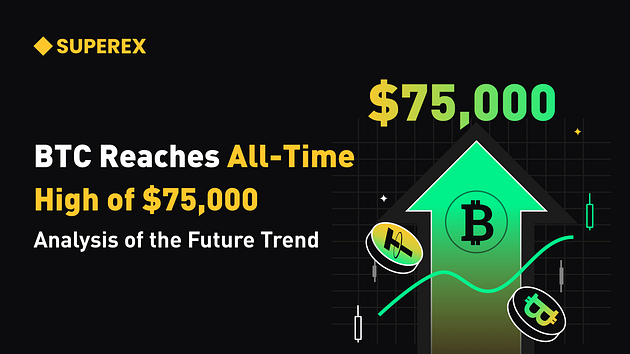SuperEx丨BTC Reaches All-Time High of $75,000: Analysis of the Future Trend

#SuperEx #BTC #Crypto
The U.S. election has concluded, and BTC’s sharp surge is unsurprising. However, its rapid climb to a new high of $75,000 has caught everyone off guard. A new era begins at this level, a new future for BTC.
With Trump’s re-election as a backdrop and BTC’s new high as a signal, what lies ahead for BTC after breaking through its historical peak? Let’s delve into an in-depth analysis. Keep in mind, this discussion focuses on macro trends, not short-term price movements, and does not constitute investment advice.
- Click to register SuperEx
- Click to download the SuperEx APP
- Click to enter SuperEx CMC
- Click to enter SuperEx DAO Academy — Space

From a global economic perspective, BTC’s rise is closely tied to market expectations following Trump’s re-election. Due to his campaign promises, the market broadly expects his administration to adopt a looser economic policy. This policy approach, particularly with potential easing of regulations on digital assets and blockchain, could further drive BTC and other crypto assets higher.
On a broader scale, Trump’s policies may exacerbate global inflationary pressures. Although global economic growth faces numerous uncertainties, central banks worldwide generally maintain loose monetary policies. As the benchmark for global finance, the U.S. plays a crucial role in the global liquidity environment. Against this backdrop, BTC is seen as a store of value and inflation hedge, gaining additional value as a “digital gold.” The high inflation rates in the U.S. and other major countries make BTC an attractive choice for investors seeking asset diversification.
Policy and Regulatory Landscape
Trump’s 2024 re-election has sparked anticipation about changes in the U.S. regulatory landscape. Similar to his stance on financial markets, many expect him to adopt a relatively relaxed approach to the cryptocurrency market. However, despite the potential for a more lenient policy at the federal level, Congress and relevant regulatory agencies, such as the Securities and Exchange Commission (SEC), may continue to focus on risk control within the market.
Historical experience shows that regulatory policies can impact BTC’s price volatility. In a market lacking clear regulatory guidelines, the influx of large funds and high volatility make investor sentiment in the crypto market more sensitive. Even if the U.S. government adopts a supportive stance toward digital assets, agencies like the SEC may still strengthen regulation over exchanges, stablecoins, and decentralized finance (DeFi).
Technical Analysis: Support and Resistance Levels
After reaching a new high of $75,000, BTC’s technical landscape shows a tug-of-war between bulls and bears. The $75,000 level is not only a psychological threshold but also a confluence point of bullish and bearish forces. While BTC has broken through this critical level, a potential pullback remains possible. Technical indicators, such as the Relative Strength Index (RSI), indicate that BTC is currently in the overbought territory, meaning it may face short-term profit-taking pressure.
From a support and resistance perspective, the next resistance level is likely between $80,000 and $85,000, while stronger support may be around $70,000. In the long run, if BTC can hold above $75,000, it could continue to attract more institutional investors, further solidifying this support level.
The Role of Institutional Investors
As institutional participation in the crypto market grows, BTC’s price volatility has gradually decreased. According to on-chain data, institutional wallet holdings have increased during the recent rally, with firms like Grayscale continually increasing their BTC positions. From Q3 2024 to early 2025, several traditional U.S. financial institutions have launched crypto-related products, such as BTC ETFs, significantly boosting market liquidity.
The stability brought by institutional investors supports BTC in maintaining high levels. However, institutional involvement also makes BTC more sensitive to macroeconomic changes, such as Federal Reserve rate hikes.
Despite an optimistic market outlook for BTC, risks remain. Global economic uncertainties are foremost among them, including the possibility of an economic downturn in the U.S. Additionally, evolving cryptocurrency policies in other countries and the ongoing development of decentralized technologies could affect BTC’s market share. For instance, the expanding Ethereum ecosystem might divert some investments into other chain projects.
BTC’s future depends on its role as a “store of value.” Although short-term market sentiment may cause fluctuations, in the long-term, widespread adoption of crypto and sustained institutional participation could drive BTC past the $100,000 mark. Achieving this target requires global economic stability and a lasting commitment from investors to BTC as a digital asset.
In conclusion,Following its new high at $75,000, BTC has entered an unprecedented phase. Trump’s re-election and potentially looser U.S. policies provide more room for growth in the crypto market. However, there are still many uncertainties in the future, whether in technical trends or macro policies. BTC’s path forward will continue to be shaped by factors such as global economic conditions, policy changes, and technological advancements.
As the world’s leading digital asset, BTC’s rise reflects the market’s demand for decentralization and inflation resistance. Over the coming years, as global investors show greater interest in digital assets, BTC is expected to further solidify its dominance in the cryptocurrency market.






Responses